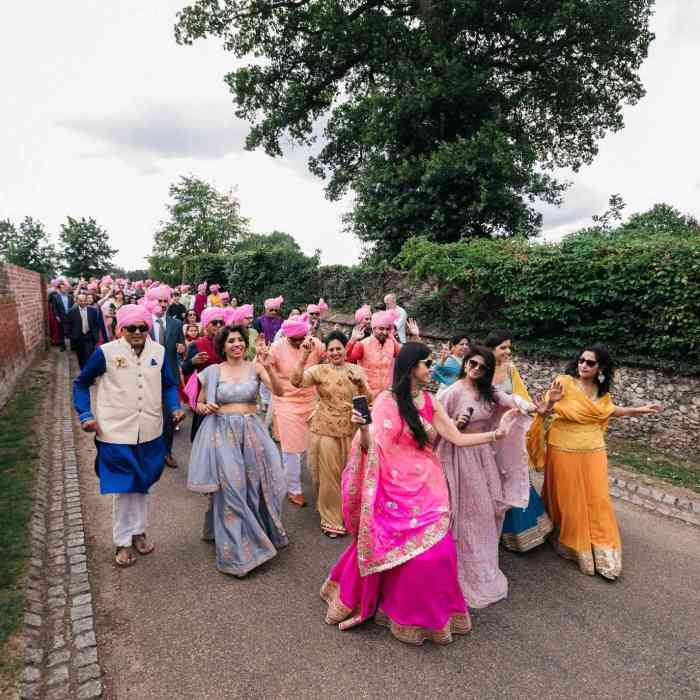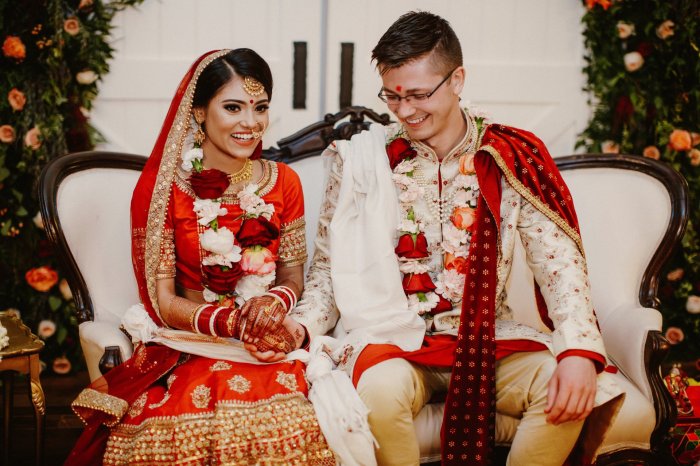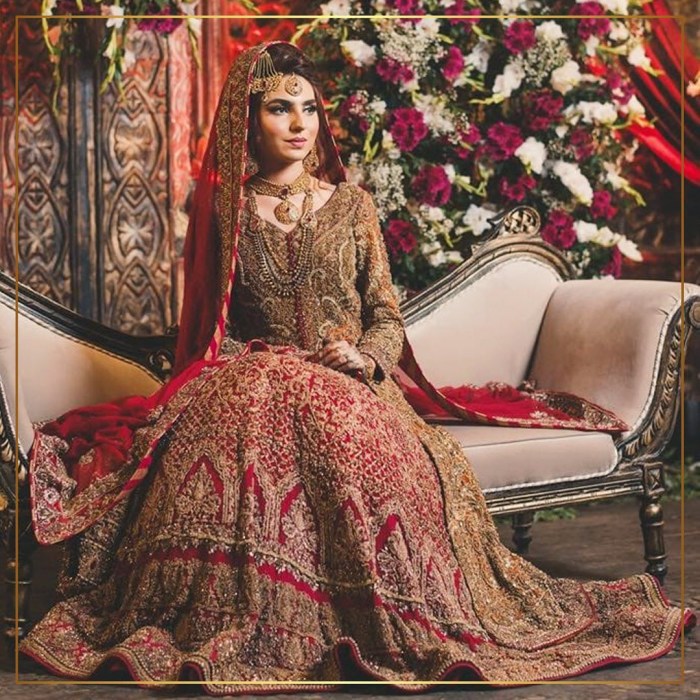Traditional Hindu Wedding Dress A Timeless Elegance
The Significance of the Lehnga Choli in Hindu Weddings
Traditional hindu wedding dress – The lehenga choli, a quintessential garment in Hindu weddings, holds deep cultural and symbolic significance. Its evolution reflects the rich tapestry of Indian history and tradition, while its vibrant colors and intricate designs tell stories of joy, prosperity, and new beginnings.
Historical Evolution of the Lehnga Choli
The lehenga choli’s origins can be traced back to ancient India, evolving from simpler garments worn by women across different regions. Initially, the lehenga was a long skirt, often paired with a choli (blouse) and dupatta (scarf). Over centuries, regional variations emerged, leading to the diverse styles we see today. The Mughal influence significantly impacted the lehenga’s design, introducing elaborate embroidery and luxurious fabrics.
The 20th century saw further evolution, with the introduction of modern silhouettes and embellishments.
Symbolic Meaning of Colors in Lehengas
Color plays a crucial role in Hindu weddings, with each hue carrying specific symbolic meaning. Red, often associated with auspiciousness and fertility, is a popular choice for brides. Other colors, like gold (representing prosperity), green (symbolizing nature and growth), and pink (representing joy and happiness), are also commonly used, reflecting the bride’s personality and regional preferences.
Regional Variations in Lehnga Choli Styles
The lehenga choli’s design varies significantly across India’s diverse regions. Gujarati lehengas are known for their intricate embroidery and vibrant colors, often featuring bandhani (tie-dye) or mirror work. South Indian lehengas frequently incorporate traditional Kanjeevaram silk and feature rich, bold patterns. Punjabi lehengas are characterized by their luxurious fabrics, heavy embroidery, and use of gold and red.
Comparison of Lehnga Choli Styles
| Style | Fabric | Embroidery | Color Palette |
|---|---|---|---|
| Gujarati | Silk, Bandhani | Mirror work, Aari work | Red, Green, Yellow, Orange |
| South Indian | Kanjeevaram silk | Zari work, temple jewellery motifs | Maroon, Gold, Red, Green |
| Punjabi | Silk, Velvet | Heavy embroidery, Zardozi | Red, Gold, Maroon, Pink |
Fabrics and Embellishments in Hindu Wedding Lehengas
The choice of fabric and embellishments significantly contributes to the opulence and beauty of a Hindu bridal lehenga. Traditional fabrics and intricate craftsmanship showcase the bride’s family’s heritage and social standing.
Traditional Fabrics
Silk, brocade, and velvet are among the most popular fabrics used in bridal lehengas. Silk, known for its luxurious sheen and drape, is a timeless choice. Brocade, with its intricate woven patterns, adds a touch of regal elegance. Velvet, with its rich texture, is often used for winter weddings.
Common Embellishments
Embroidery, zari work, and mirror work are common embellishments that add intricate detail and visual appeal to the lehenga. Embroidery involves stitching intricate patterns using threads, while zari work uses metallic threads for elaborate designs. Mirror work, a traditional craft, involves sewing small mirrors onto the fabric, creating a dazzling effect.
Regional Variations in Embroidery
Different regions of India boast unique embroidery styles. Kantha embroidery from Bengal features running stitches creating flowing patterns. Phulkari from Punjab uses vibrant floral motifs, while Kashmiri embroidery is characterized by its intricate floral and paisley designs.
Five Embroidery Techniques
- Zardozi: Intricate metallic thread embroidery, often using gold and silver.
- Aari: A type of embroidery done with a hook-like needle, creating detailed patterns.
- Chikankari: Delicate white embroidery on sheer fabrics, originating from Lucknow.
- Banarasi: Intricate brocade weaving using gold and silver threads, typical of Varanasi.
- Patchwork: Combining different fabrics and colors to create a unique design.
Jewelry and Accessories for the Hindu Bride: Traditional Hindu Wedding Dress

Source: brides.com
Traditional jewelry plays a significant role in a Hindu bride’s attire, symbolizing prosperity, good fortune, and blessings for her marital life. Each piece carries cultural significance and regional variations.
Significance of Bridal Jewelry
The jewelry worn by a Hindu bride is more than mere adornment; it’s a reflection of her heritage, family status, and auspiciousness of the occasion. Each piece holds symbolic meaning and contributes to the overall aesthetic of the bridal look.
Key Pieces of Bridal Jewelry
A Hindu bride typically adorns herself with a variety of jewelry, including bangles (for protection and prosperity), necklaces (representing marital bonds), earrings (symbols of beauty and femininity), and anklets (signifying grace and elegance).
Regional Variations in Bridal Jewelry
Regional variations are prominent in bridal jewelry. South Indian brides often wear heavy gold necklaces with intricate designs, while North Indian brides may opt for a more elaborate array of bangles and necklaces.
A Complete Bridal Jewelry Set
A heavy gold necklace, often featuring intricate pendants and chains.
Elaborate jhumkas (bell-shaped earrings) and other traditional earrings.
Numerous bangles, often made of gold and adorned with precious stones.
Intricately designed anklets, sometimes with bells or other embellishments.
A maang tikka (forehead ornament) that adds a touch of elegance and completes the bridal look.
Makeup and Hairstyles for Hindu Brides
Traditional makeup and hairstyles enhance the beauty of the Hindu bride, reflecting the rich cultural heritage and adding a touch of elegance to the wedding attire.
Traditional Makeup Styles
Traditional Hindu bridal makeup emphasizes a natural look, focusing on enhancing the bride’s features with subtle colors and highlighting the eyes and lips. The use of natural ingredients is often preferred.
Significance of Makeup Elements
Sindoor (vermilion powder) applied on the forehead is a symbol of marital status and good fortune. The bindi, a decorative dot on the forehead, represents the third eye and spiritual energy.
Traditional Hairstyles
Traditional hairstyles for Hindu brides are often elaborate, involving intricate braids, buns, and the use of flowers and accessories. The style often depends on the region and the bride’s preference.
Creating a Traditional Bridal Hairstyle

Source: cdn-website.com
The process involves carefully braiding the hair, often incorporating extensions for added volume and length. The braids are then arranged into a bun or other elaborate style, secured with pins and embellished with flowers, jewels, or other accessories. A final touch might include a veil or dupatta draped over the hairstyle.
Modern Interpretations of Traditional Styles
While tradition remains deeply rooted, modern interpretations have infused contemporary elements into the traditional Hindu wedding dress, creating a unique blend of classic elegance and modern aesthetics.
Evolution of Traditional Styles, Traditional hindu wedding dress
Traditional styles have adapted to modern tastes, incorporating contemporary silhouettes, fabric choices, and embellishments while retaining the essence of traditional designs.
Traditional vs. Contemporary Styles

Source: wedmeplz.com
Traditional Hindu wedding dresses, often vibrant and richly embellished, showcase the bride’s beauty. For guests attending such a vibrant celebration, finding the perfect attire is key; consider elegant options like those found at short sleeve elegant dresses for wedding guests , which offer a sophisticated yet comfortable choice. These complement the festive atmosphere without overshadowing the bride’s stunning traditional ensemble.
Contemporary styles maintain the elegance of traditional lehengas but often feature more streamlined silhouettes, lighter fabrics, and unique color combinations.
Influencing Trends
Modern trends have introduced pastel shades, minimalist designs, and unconventional fabric choices, creating a balance between tradition and contemporary fashion.
Modern Twists on Traditional Elements
| Style | Modern Element | Traditional Counterpart | Overall Effect |
|---|---|---|---|
| Lehnga Choli | Pastel shades (e.g., blush pink, lavender) | Vibrant red or maroon | Subtle elegance, romantic feel |
| Lehnga Choli | Lightweight fabrics (e.g., georgette, chiffon) | Heavy silks and velvets | Modern comfort, airy elegance |
| Bridal Jewelry | Minimalist designs, delicate necklaces | Heavy gold necklaces and elaborate sets | Modern sophistication, understated elegance |
Clarifying Questions
What is the significance of the sindoor in Hindu bridal makeup?
Sindoor, a red powder, symbolizes marital status and good fortune for the bride. It’s applied in the parting of the hair.
How long does it typically take to get ready in a traditional Hindu wedding?
The entire preparation process, including hair, makeup, and dressing, can take several hours, often requiring the assistance of multiple people.
Are there specific religious rituals associated with the wedding attire?
Yes, certain rituals involve specific garments or the application of certain adornments at particular points in the ceremony.
What are some modern alternatives to traditional fabrics?
Modern brides often opt for lighter fabrics like net or georgette while retaining traditional embroidery styles.



















